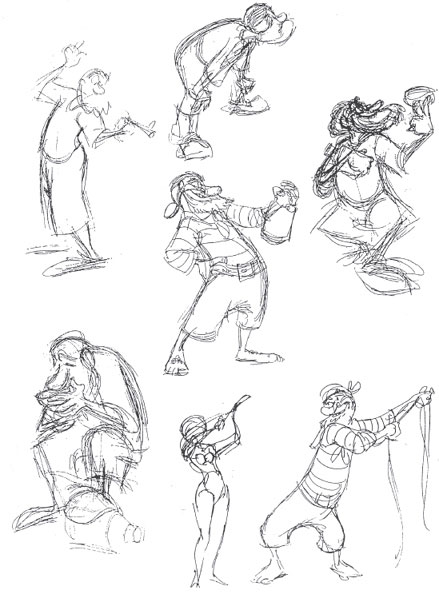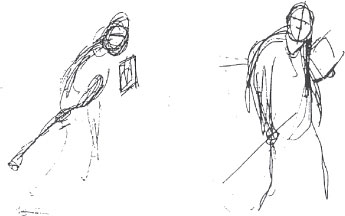Last week I nearly got lynched because of a handout with no illustrations, so in self-defense, if nothing else, I submit to the insatiable appetite of artists for illustrated texts.
Herein are some more drawings from the evening class with my suggestions. Please understand these are not “how-to-draw” corrections, they are suggestions designed to encourage the artist to analyze the pose rather than simply attempt to copy it. If the model is bending over, for instance, the thought “bending over” must register in the artist’s mind. This allows her or you to say, okay, the model is bending over, what can I do in my drawing to put over that idea. By imagining the feel or sensation of bending over or by actually getting up and mimicking the pose you can personally experience the tensions on certain muscles, the distribution of weight, and whatever else it takes to carry out that particular task.

The “whatever else” depends on what the story is behind the bend. For instance, a simple bend might require just the hips (tail end) to protrude as a counterbalance.
If the back is arched, the head will automatically raise, for the neck has a tendency to continue the action of the backbone.
If the back is bent the other way the head will be forced to lower itself because the spine is bent over and the neck is part of the spine.

If the knees are bent, the hips do not need to protrude so far in back, because when the knees bend forward there is less need for counterbalance. Besides, the hips have to follow wherever the knees go.
When the back is arched the other way there is more flexibility in the neck area so the head can tilt straight up or almost straight down.
These things may all seem boringly obvious to you but you can see how important it is when interpreting a gesture with a bend in it — to say nothing of all the modifications and combinations involving arms, legs, knees, hips, shoulders, etc. Mind you, I have just touched the surface of the bend. There are limitless poses that require the same careful analysis to make sure they are appropriate anatomically and gesturally. Physiognomy is a good word to contemplate in this regard. It means, in part, “The art of discovering temperament and character from outward appearance… hence inner character as revealed outwardly.”
Sometimes when drawing a model in a bending pose, the action is not all that apparent, so to get some dynamics into the drawing, you have to either know what is taking place intellectually, or feel it kinesthetically. Here is a fairly nice drawing of a possible Ariel (done by the way, from a male model with a sailor outfit on) in a bend that is slightly passive. I suggested two alternate bends that might have conveyed the impression that the character was a little more excited about what she was looking at.
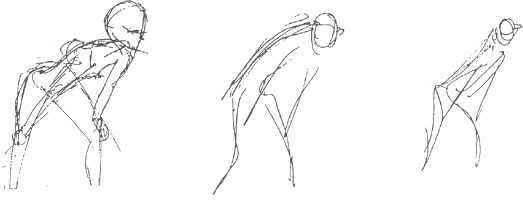
If you try to pick out lines on the model to copy, you will often be thwarted, for the lines needed to put over the action may not be there. In such a case you would have to “feel” the action and create lines that would communicate it. In this next pose the left side of the model was a nebulous jumble forming an almost straight vertical line. All it yielded by way of expression was a tangent — clear from the shoulder to the ankle. It needed a clarified line to depict what was happening.
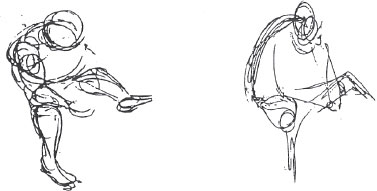
The next drawing is a very interesting one. It is an expressive drawing, but the model happened to be bending into the point of interest quite a bit more, hence my suggestion.
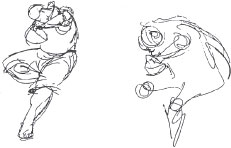
The next pose was a very subtle one where the model was slightly bent over, staring blankly into air as if contemplating something. I suggested a little more bend with the face (and eyes) protruding as if looking into a mental image-balloon a few feet in front of him.
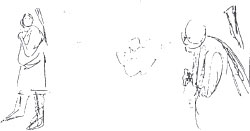
The next pose is one where the model was reaching for something below the edge of the model stand. To strengthen the pose I merely planted the right hand, right knee, and left foot, then stretched (and bent) him forward into the stretch. This brought his right shoulder forward causing a forward tilting angle on the right arm. It also thrust his chest and head forward so there is more weight on the right hand. Plus it got his eyes out in the open, creating an uncluttered path for the look. These things can be spotlighted if the pose or gesture is analyzed from the standpoint of the “story” behind the pose.

In the next drawing, I stopped the artist before he had a chance to work out his problem. The man is tired from carrying this heavy box. He is slumped over, perhaps looking back to see if anyone is following him. Is there something valuable in the box; perhaps his entire belongings? Or has he stolen something and is edgy about being apprehended? Any such story points will inspire you to select the essential elements for putting them over.
One of the interns asked me, what about days when you just can’t seem to draw anything? I suggested he create a project like drawing a bend or a stretch or some action like that, which requires getting involved on a “story” level, where he can forget “drawing.” Working out ways of putting over a story will suggest ways of drawing it. When you say, “squash or stretch,” “joy,” “fright,” or “take,” there suddenly appear ways of depicting these actions or emotions. You don’t sit down and start drawing muscles or clothes or legs or arms. What you draw is a squash or stretch or joy or a “take,” etc. If one of the lines you put down seems to suggest what you have chosen to illustrate that line will inspire others that will “chip in” and help. On the other hand, if you are too involved in “drawing,” per se, you might forget what you started out to do.
Drawing is not easy. It requires a lot of thought. So keep your mind agile. Flex it constantly so that it doesn’t atrophy. Give it the reins and let it soar at times. Other times subdue it and utilize its fantastic range of possibilities.
Here is one more drawing in this series. It’s not a bend problem, but a tangent problem. The right leg seems to go right back to the left hip. A simple adjustment remedies the illusion.
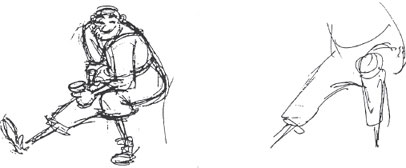
The last page of this handout is a bonus selection, devoted to some excellent drawings that are translations of the live model into a character from the “Mermaid.” These are “cold” translations by artists who have not drawn the character before. It is heartening to see such resourceful and skillful powers of adaptation.
